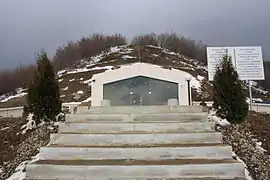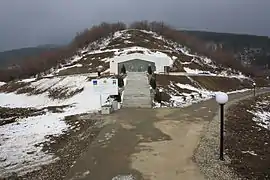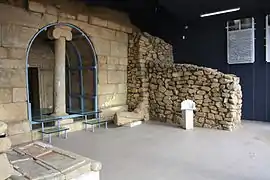
Outside view

Panorama view

Inside view
The Thracian tomb at Shushmanets is a mound located in the Valley of the Thracian Rulers. It was built as a temple in the 4th century BC and later used as a tomb.[1]
Architecture
The temple has a long and wide entry corridor and an antechamber, a semi-cylindrical room supported by an elegant column. The top of this column has the form of a knucklebone. Four horses and two dogs were sacrificed in the antechamber. The central room is circular in shape, supported by a beautiful polished Doric column ending with a large disc symbolizing the sun. The tomb's columns represent Thracian beliefs about the universe and the creation myth. Archaeologist Georgi Kitov discovered the tomb in 1996.[2]
See also
- Thracian tomb of Aleksandrovo
- Thracian tomb of Cotys I (Mogilan mound)
- Thracian tomb Golyama Arsenalka
- Thracian tomb Griffins
- Thracian tomb Helvetia
- Thracian Tomb of Kazanlak
- Thracian tomb Ostrusha
- Thracian tomb of Seuthes III
- Thracian Tomb of Sveshtari
- Valley of the Thracian Rulers
- Roman Tomb (Silistra)
References
- ↑ "The Tomb in the "Shushmanets" Mound". Wikimapia. Retrieved July 15, 2013.
- ↑ "Thracian tomb in Shushmanets mound, Shipka". Guide Bulgaria. Retrieved July 15, 2013.
This article is issued from Wikipedia. The text is licensed under Creative Commons - Attribution - Sharealike. Additional terms may apply for the media files.